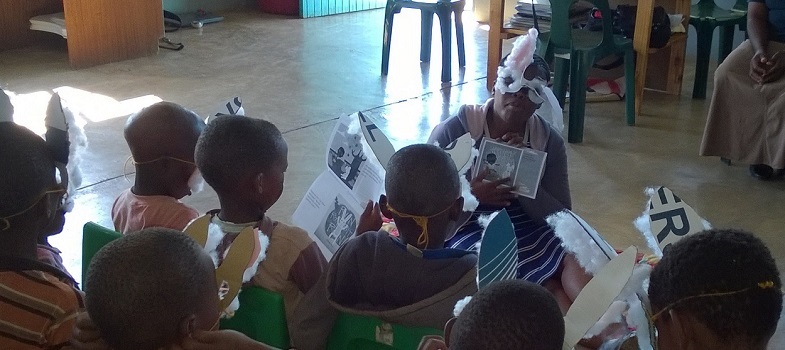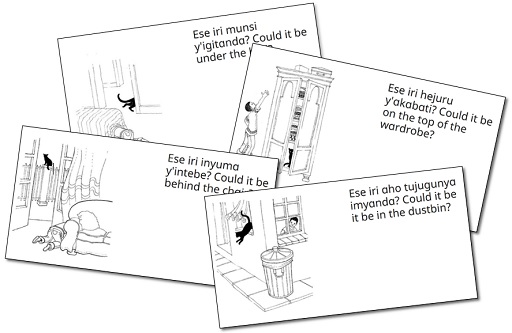Questioning in the classroom
In Case Study 3.1, Patrick uses a picture storybook to get his class thinking by asking different kinds of questions. As you read the case study, think about how you can use these ideas in your early reading teaching.
Case Study 3.1: Using questioning in the classroom
Patrick teaches at a school not far from Kigali. Unlike any other countries in Africa, almost everyone in Rwanda speaks one language: Kinyarwanda. He is a qualified and experienced primary teacher, although he has not taken any early childhood education qualifications, which have only just been introduced into pre-service courses at teacher training colleges. Teaching at pre-primary level is something that has only recently become widespread in Rwanda and schools lack resources for early childhood development (ECD).
Patrick has also recently come across the ASb website and wants to try and use a storybook in his class in order to extend the children’s thinking and speaking skills. He chooses the storybook Where is My Cat? [Tip: hold Ctrl and click a link to open it in a new tab. (Hide tip)] , because it has very simple pictures with a repeating pattern in the text. It is also full of questions and opportunities for children to express their own ideas. It is available in both Kinyarwanda and English, and Patrick thinks he can use it in many ways to develop his children’s early reading skills.
Having downloaded and printed a copy of the book, Patrick brings all the children to a sitting space at the front of the class. He wants every child to be involved and brings them close to him so that they can all see the book and he can glance around and catch every child’s attention. All of his children are very excited.
Patrick decides to introduce the book by showing only the title page, which has no writing. He sits on a chair, shows the first picture and asks a closed question: ‘What animal is this?’ All of the children can answer that it is a cat. He asks another closed question: ‘What colour is the cat?’ Nearly all of the children are happy to chorus that it is a black cat. He asks some more closed questions: ‘Can you see the eyes?’ ‘Can you see the legs?’ All of the children are able to answer.
Then Patrick decides to ask an open question: ‘What do you think this story is about?’ He expects lots of hands up, but no one wants to answer. There is silence. He realises that there are lots of possible answers to this open question, and no child wants to get it wrong!
He decides to ask the children to hold hands with one neighbouring child: this is their talking partner. He tells the children they can talk over the question with their talking partner. He again asks: ‘What is this book about? What is the cat doing and what happens to him or her? Talk it over with your partner. I will raise my hand when I want you to stop talking.’
All the children begin talking to their partner about what the book can be about. Patrick moves around the pairs listening in to their conversations. When he thinks that all pairs have had a good chat, he raises his hand to stop the talking and asks the children to raise their paired hands if they have thought of an answer.
Patrick is delighted! Now nearly all the pairs of hands are raised. Even children who normally never put up their hand are happy to do so with a partner. The children have thought of lots of possible answers:
- ‘The cat is hungry and wants some food.’
- ‘The cat is lost and is looking for his home.’
- ‘The cat is lonely and wants a friend.’
- ‘The cat is a mummy who has lost her kittens.’
Some children even think the book will be about lots of animals of different colours. The children have thought of these imaginative ideas by working in pairs and Patrick is very pleased with how much thinking and speaking has taken place in his classroom. The storybook has really captured their interest: the children are now very curious to find out what the story is really about …
In future weeks, Patrick is able to read the whole book to the children. Because it has repetitive text, the children begin to know it by heart and are able to:
- answer the closed questions on every page (such as ‘Is the cat under the bed?’ ‘NO!’)
- think of a name for the cat and imagine where it is going in between each picture
- draw and cut out a cardboard cat and furniture to use as props as they retell the story.
Eventually Patrick is able to use this storybook to introduce reading skills. (See Section 4 for different approaches to teaching reading.)
Patrick’s reading lesson was very successful. By asking both closed and open questions, he was able to encourage the children to think about the story, and could identify which children had understood the question.
Activity 3.2: Reflecting on the case study
Read Case Study 3.1 again with a colleague and write down in your study notebook the different strategies that Patrick used to encourage active participation. Some initial suggestions are that he:
- gives the children time to think
- creates talk partners
- chooses an interesting story.
Discussion
Patrick is a very effective and skilled reading teacher. He also knows his children well and is confident in letting them talk to each other. He employs many strategies – how many of these did you have on your list? The different strategies that Patrick used to support the children’s early reading skills included:
- developing comprehension skills
- sharing ideas about the story with their friends
- practising reading the repetitive words
- enjoying listening to the story
- joining in with Patrick as he reads.
You may have written down more ideas. Find some time to discuss these strategies with a colleague, and then choose one to try out in a reading lesson next week.
(With simple books like this, if you are not able to print them then perhaps you could copy them on to large pieces of paper to share with the class?)
In the next activity you’ll return to the storybooks you looked at in the last section of the course.
Activity 3.3: Asking questions
In Section 2 you downloaded three stories from the African Storybook website. Re-open these stories, skim-read them and choose your favourite one.
You are now going to write six questions about the story that you could ask the children in your class. You can fill in this template and print it out or you can write your questions in your study notebook. Think about using both closed and open-ended questions, returning to Patrick’s story in Case Study 3.1 if you need to.
Developing comprehension and thinking skills through questioning




